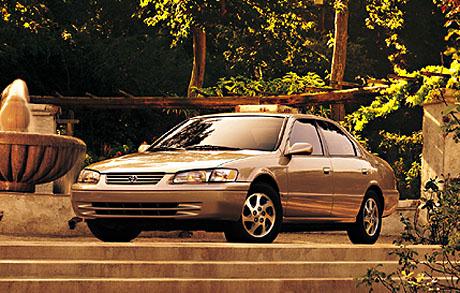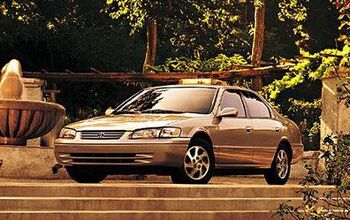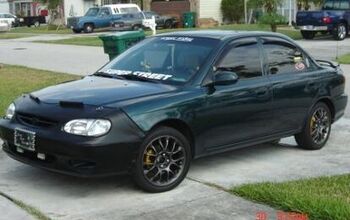Hammer Time Rewind: The Toyota Reality
A quarter century ago, give or take a year, my brother Paul became the first in the family to drive a Toyota. A 1984 Toyota Celica-Supra. It was a true shifting of gears for the Lang Gang. Everyone up to that time had bought a GM. Mom and Dad drove Cadillacs (only one saw 100k). The eldest one had a Monte Carlo (a.k.a. Crapo) that didn’t see the road half the time. Second in line had a Regal (a.k.a. the dying diesel) that ended up stolen and trashed in the Grand Canyon. He actually felt sorry for the canyon.
Within three years both these Roger Smith specials were replaced with 1988 Celica GT’s. Great cars with no nicknames necessary. Three years later I had a Celica GT-S sitting on my driveway. Even better. Still no nicknames. By the end of the decade everyone in the family had a Toyota.
But then things changed…
Toyota’s quality took a sharp U-Turn and unintentionally accelerated towards the ‘decontenting’ highway starting in the late-90′s. The 1997 Camry, 1998 Corolla, and pretty much every other Toyota that wasn’t a luxury car or first generation (RAV-4 and Sienna) went straight to the crematorium of cost cutters. “Affordability is the No.1 priority,” said the 1997 Camry chief engineer Kosaku Yamada. “The Camry is not a luxury car.” and so it became the harbinger of things to come.
The fourth generation Camry (1997 – 2001) in fact became number one. Not just by beating the Accord and Taurus. But by crushing them into a fine red mist for its entire model run. This was Toyota’s first truly competitive ‘decontented’ model and the net result was about $1500 to $2000 per vehicle. Multiply that by the nearly 2 million Camrys that went out the door and Toyota had finally found a true cash cow. ‘Cost improvement’ along with ‘decontenting’ soon became a big part of the Toyota way.
Some of the decontenting was based on the reduction of parts. Front bumper clips and components were reduced from 57 to 15. The doors triple seal rubber in the prior generation gave way to a single seal. Others were a bit more pronounced.
The dashboard material felt a bit cheaper compared with the old model. Items that were once power, such as the antenna, became manual. Bulbs became cheaper. The engine bay became a little less ostentatious. The biggest issue though became the increased incidences of engine sludge inside the 2.2L four and 3.0L V6. Toyota would eventually have over 3.5 million engines subject to the settlement. This would be Toyota’s first real black eye on the media front along with 10 safety recalls during this generation’s model run. Judging on the feedback from owner enthusiast sites around the net, the ‘real’ customer satisfaction ratings also started to take a beating.
At the time of the Camry’s release in 1997, Toyota still had an ironclad reputation to fall back on. Go to carsurvey.com and look up the Toyotas that came before that time. A 1990 to 1996 ‘anything’ with the name Toyota on it was literally two clicks above anything else save the occasional Civic or Accord. You couldn’t kill these models once you turned the key. Even when my beloved Celica GT-S was hit by a meat truck driven by a drunk Greek, the underpowered engine kept right on ticking away. I’m sure someone’s using that engine somewhere.
But damn were Toyotas expensive before the ‘decontenting’ period. In 1994 I could not get a Camry with ABS to replace the Celica for less than $20,000 retail in my neck of the woods. We’re not talking MSRP…. but retail… before tax, tag and title. I should know because I eventually had to go several states away to find one close to that price. That one has lasted 280k+… but Toyota’s problem was that folks simply didn’t buy on the perception of quality alone. Price, features, and performance were the elixirs for most car buyers of the time. Toyota had flashes of greatness with features (Lexus LS and SC) and performance (Supra). But the big P was where Toyota simply didn’t have it anywhere in their line-up.
Part of the fault was with the Yen. Toyota couldn’t make the big jump from being the ‘quality champion’ to ‘sales champion’ because their cars were just too expensive out the door if they were sourced and built in Japan. Honda offered a smaller and cheaper Accord that was heavily sourced in America by the early-90s. Ford had a Taurus that was corner cut and subsidized by everything from rental car companies to an absurdly ancient powertrain. While Toyota would offer families a $20,000 Camry with ABS. You could far more easily get one from Ford that was $4,000 cheaper… the Accord was $2,000 cheaper. Both of them were well thought of in the marketplace with Honda’s Accord being the retail sales chamption.
Unfortunately for Toyota, that wasn’t even the half of it. The bigger problem was Toyota itself. It was old. As in lifetime employment, perhaps one quarter of their corporate employees hanging out and reading newspapers old. Maryann Keller had written a book pretty much highlighting the fact that Toyota’s bureaucracy was riddled with a conservative and intensely loyal faithful that made ‘The Toyota Way’ front and center. But by the time 1997 reared it’s head, they were pulling down big salaries with little to do.
To make matters worse, Toyota really couldn’t stop spending once it fell in love with an idea. The 1st generation Lexus SC400 was the perfect example of this cost no object approach. Toyota wanted to build a coupe that was completely different from the conventional styles of the time. All curves, no flat edges, no flat surfaces. It was done… but the costs for developing the body stamps and assembly line technologies went well into the mid-hundreds of millions. Throw in the the SC 400′s 4.0 L V81UZ-FE engine which reportedly cost over $400 million, and Toyota had a billion dollar financial bomb in its hand. Even though the Lexus SC would remain beloved and sought after by many, few were willing to pay for a luxury coupe whose price would rise from $40k to nearly $60k within a single generation.
The period right up to 1996 represented a very unique point in time for Toyota. They could offer customers a great car. But oftentimes the engineering prowess would simply run roughshod over the financial realities of the marketplace. The same unprofitable fate for the SC would eventually be true for other Toyota models. The eight year run of the pathetically spartan Tercel, the tin can mid-1990′s Toyota Corolla, even arguably the last generation Supra. Toyota simply wasn’t the leader in any particular segment when it came to offering value in the marketplace.
By the late-1990′s Toyota was all too ready to move in a more profitable direction. A shift that would be heavily based on replacing the ‘Q’ word with the $ sign.
Note: This article was originally written on January 20, 2010. The next day Toyota issued an initial recall of 2.3 million vehicles due to throttle issues. A week later Toyota announced the recall of 7.5 million vehicles due to pedal related issues. On January 29, 2010 another 1.88 million vehicles were recalled globally for the same issues. Toyota would receive an exoneration from NASA and the NHTSA for electronic steering malfunctions, but ongoing litigation and recall issues have continued to plague the company.
More by Steven Lang
Latest Car Reviews
Read moreLatest Product Reviews
Read moreRecent Comments
- Probert They already have hybrids, but these won't ever be them as they are built on the modular E-GMP skateboard.
- Justin You guys still looking for that sportbak? I just saw one on the Facebook marketplace in Arizona
- 28-Cars-Later I cannot remember what happens now, but there are whiteblocks in this period which develop a "tick" like sound which indicates they are toast (maybe head gasket?). Ten or so years ago I looked at an '03 or '04 S60 (I forget why) and I brought my Volvo indy along to tell me if it was worth my time - it ticked and that's when I learned this. This XC90 is probably worth about $300 as it sits, not kidding, and it will cost you conservatively $2500 for an engine swap (all the ones I see on car-part.com have north of 130K miles starting at $1,100 and that's not including freight to a shop, shop labor, other internals to do such as timing belt while engine out etc).
- 28-Cars-Later Ford reported it lost $132,000 for each of its 10,000 electric vehicles sold in the first quarter of 2024, according to CNN. The sales were down 20 percent from the first quarter of 2023 and would “drag down earnings for the company overall.”The losses include “hundreds of millions being spent on research and development of the next generation of EVs for Ford. Those investments are years away from paying off.” [if they ever are recouped] Ford is the only major carmaker breaking out EV numbers by themselves. But other marques likely suffer similar losses. https://www.zerohedge.com/political/fords-120000-loss-vehicle-shows-california-ev-goals-are-impossible Given these facts, how did Tesla ever produce anything in volume let alone profit?
- AZFelix Let's forego all of this dilly-dallying with autonomous cars and cut right to the chase and the only real solution.


































Comments
Join the conversation
My 60 series Land Cruiser made it 300k before it needed costly repairs and I sold it. My 80 series Land Cruiser has 250k and has some bad window switches in the back. My 1999 4Runner made it 90k before its 4cyl engine sludged to hell and the AC broke. My 2007 FJ Cruiser made it 50k before the transmission exploded, the paint peeled off of the roof, and the t-case broke. With the proper detailing the Cruisers could still be made to look "new" after 10 years of use. The 4Runner and FJ Cruiser looked ragged and ratty after less than 2 years of use.
Its kinda sad to read about Toyota's sad decline. They are so drunk on profits, I dont believe the previous quality will ever be present in their vehicles again. They once had all the goods, all the mojo. My family has had several Toyota Pickups (best one, an '83 owned by my grandfather went to 452k.) I had a 1995 Tercel which I bought with 88k, sold with 108k. Wishing I had kept it all these years later but what can you do? That car was very well built and superior to most cars I have owned, older Camry exculded. Currently in 2013, Im still driving a 1992 Camry V6 LE. 157K. In terms of build quality, it is still superior to anything currently on a Toyota showroom floor. A little clean-up and detail and my baby shines like new, 21 years after manufacture. My grandmother purchased new in January, 1992. Knowing the extreme quality and reliability of the 80's and 90's Toyota's my family has had, its painful to see such a once great company become a caricature of its former self. And isn't it ironic as well? Toyota wanted the #1 spot from Ford for the 1992-95 Taurus, and the Taurus wanted to beat the Camry of 1992-96, even though it was already ahead in the marketplace mainly due to the Camry's price. So what happens? Toyota releases the '97 Camry thats more on par with the '92-'96 Taurus and Ford released that '96 Taurus, which was more on par with Toyota's previous Camry in terms of build quality. All very bizarre. And maybe yes, most drivers wont care about deleted triple seals on doors and other small things that Toyota, as well as other manufacturer's will hope you dont notice. But im not most drivers. and there are others out there who feel the same way I do. Maybe cutting corners isnt so bad at first. Names and imagery carry a lot of clout too, and are also very powerful tools that are all part of the illusions that car companies create and try to maintain. Circa 1997, the name "Camry" had a LOT of clout, and loyalists couldn't wait to get their hands on the new model. They sold tons of course. By 2002, another model comes around and there have been more corners cut, although at that point, granted, a lot of competition wasn't up to snuff.....GM, Ford, & Chrysler all had mediocre quality compared to the big T, And at first glance it was believable. By the time the 2007 model arrived though, the damage had been done anyway. The Camry had suffered through a decade of waning reliability and quality wasn't a top priority. The 2007 model was a decent car but was not the best Toyota could do. I have rented two, and a good friend owns a 2008 model. hands down my least favorite generation of Camry. Cheap where it counts, so that it can provide stupid infotainment features and generally just a car that is a shell of its former self, its former glory. While I don't find the 2012/2013 models wholly offensive, they have placed the car into a generic grave. Milquetoast, bland, and more homogenized than ever. Toyota can turn it around or remain doomed to become the imported Buicks of the future. I had a few Tauruses. A 1992 GL Sedan 3.8L Essex and a 1993 Wagon LX 3.0L Vulcan. Both were fairly reliable but nowhere near a '92 or '93 Camry in terms of refinement or build quality and assembly prowess. I had a 1997 Taurus GL later on. A much more improved car in terms of quality that lost out due to its fish face looks. 2000-'07 Tauruses are nothing special either, with that excruciatingly ancient powertrain. Camry took a step back to the territory filled by the 1992-95 Taurus. An extremely popular mass market sedan that eats up sales charts in spite of its fairly average reliability. Where the Taurus had bigtime transmission issues, the Camry offered an engine sludge nightmare. The 1997-01 Camry is an ok car. Its looks never bugged me, and some of its attributes I do like, and ive seen plenty of them go the long distances of the 1983-96 Camry Models. But something about it just screams "Hello, im Toyota and Im selling out".